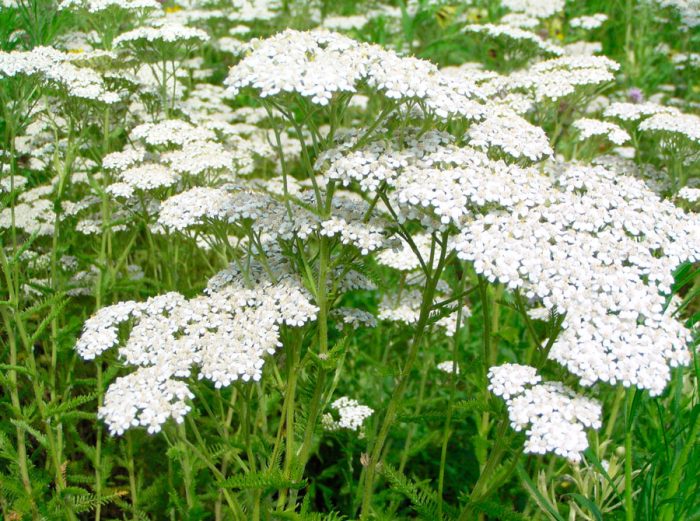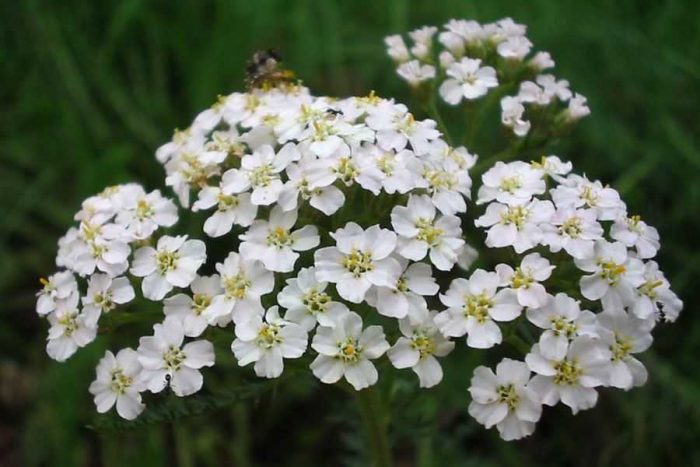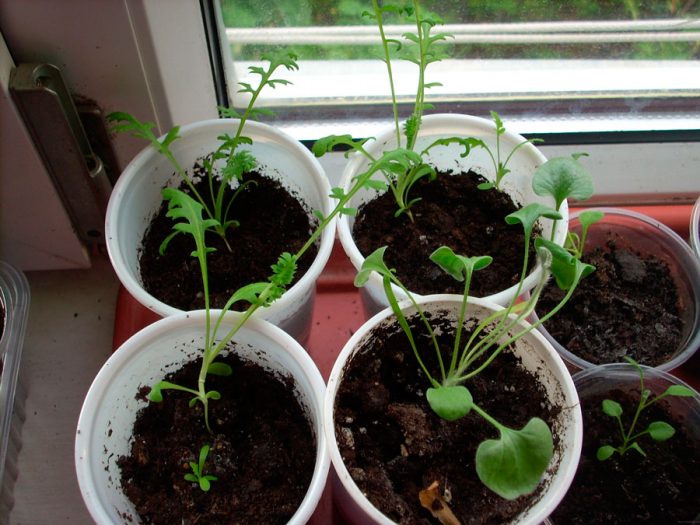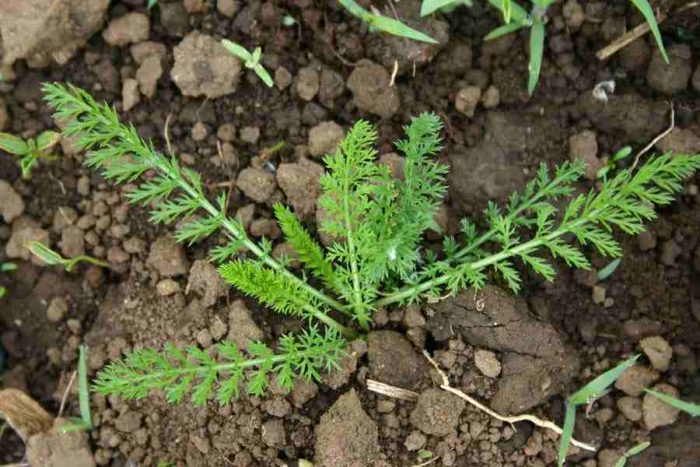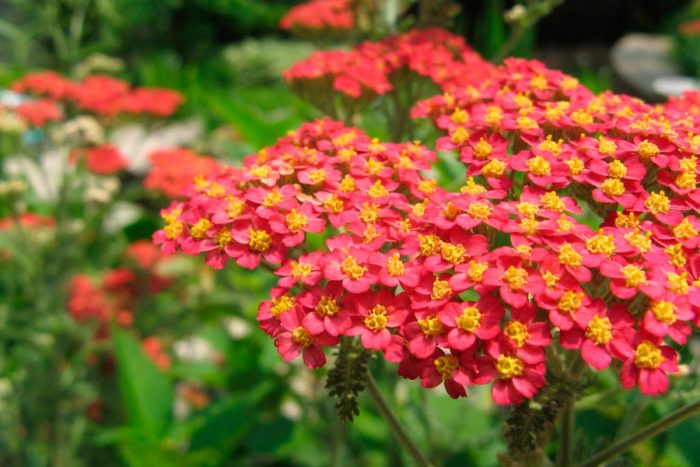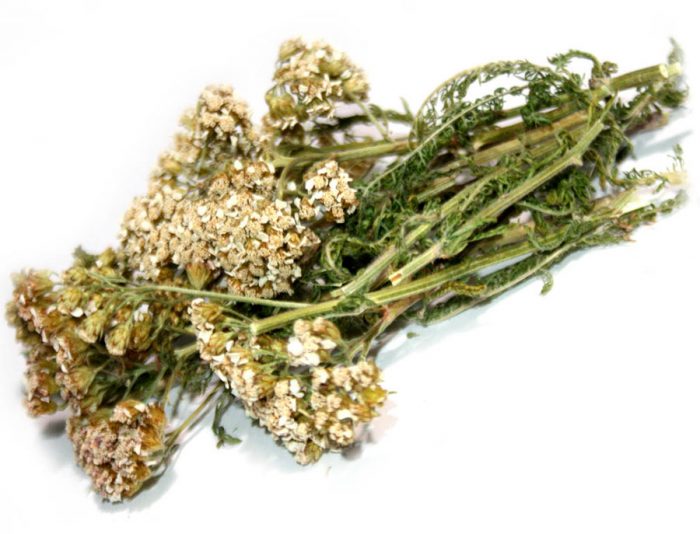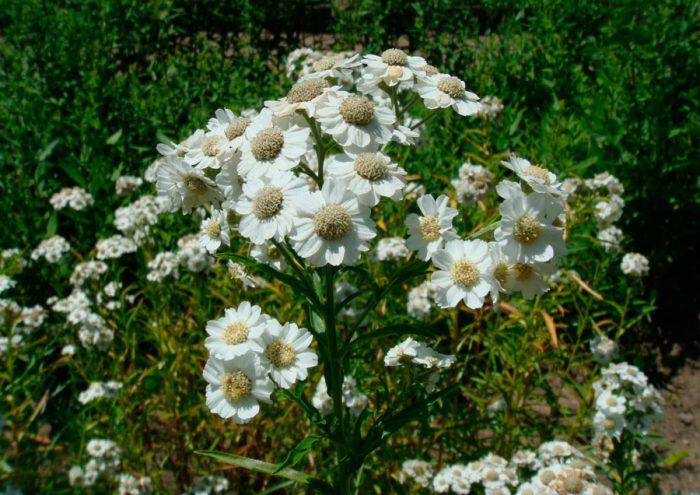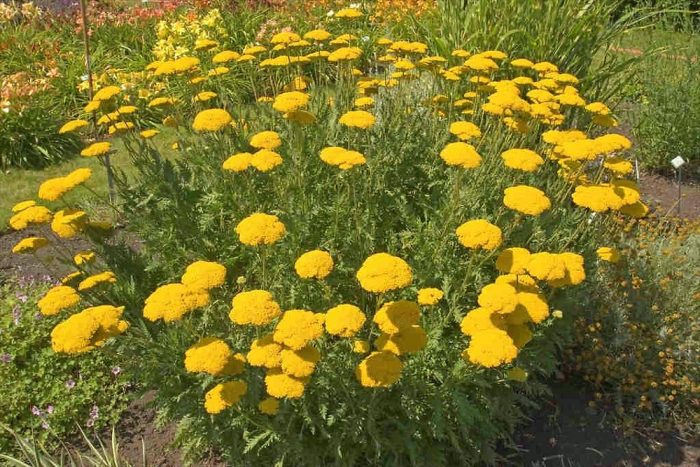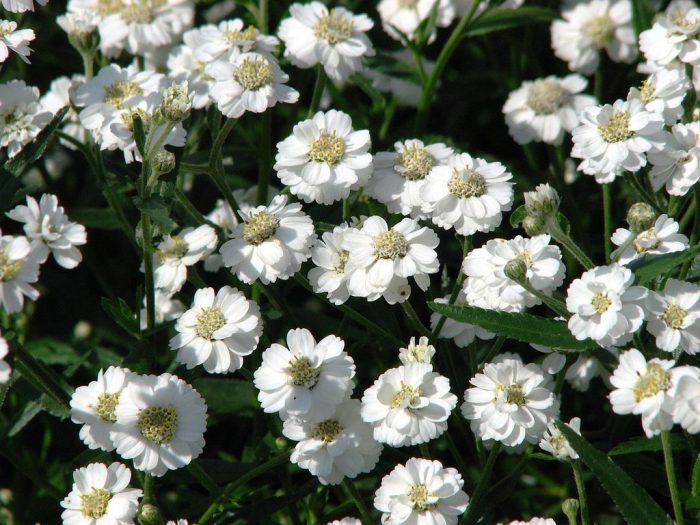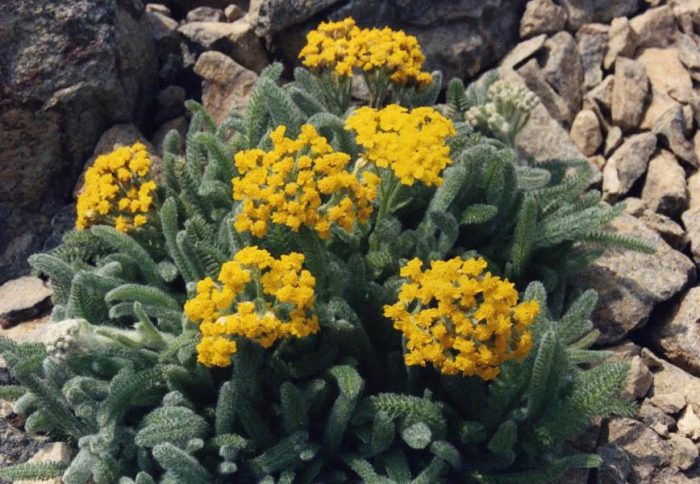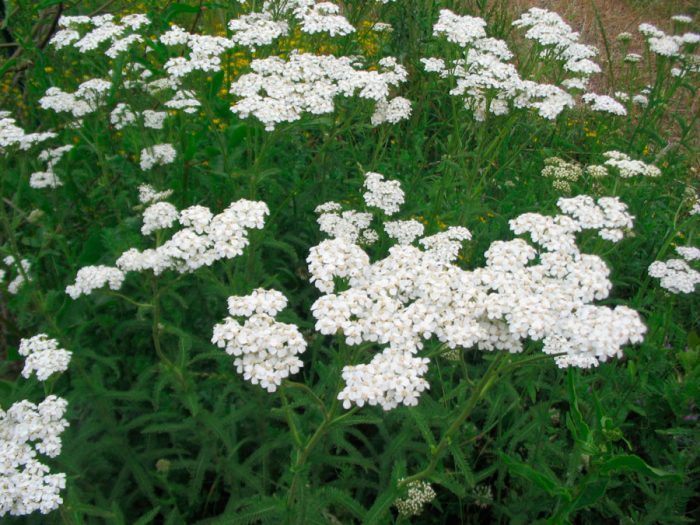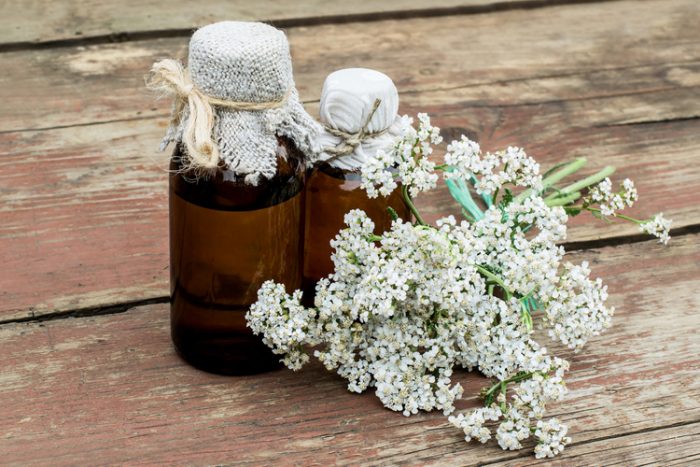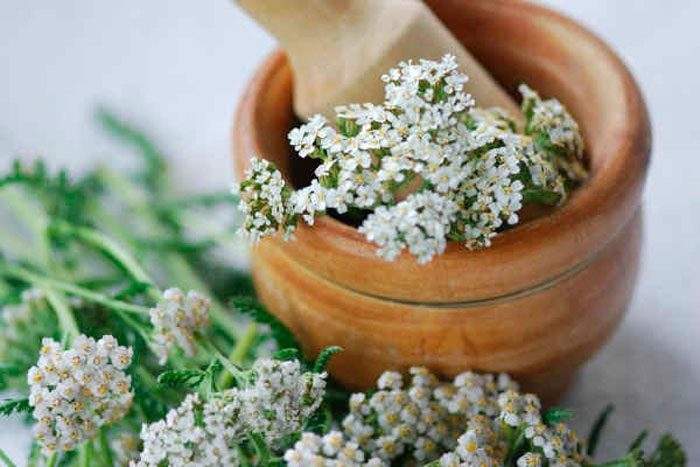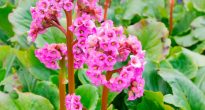Yarrow is a very large genus belonging to the family Asteraceae, or Asteraceae. This genus unites about 150 species. Cut grass, or yarrow (Achillea millefolium) is considered a type species of the genus Yarrow. The name of such a plant comes from the name "Achilles", this mythical hero healed wounds with the help of yarrow. Due to the many segments of the leaf plate, this plant received such a specific epithet ("mille" - a thousand, "folium" - a leaf). This plant is widespread in Asia and Europe, and it was also brought to other continents. This culture prefers to grow in the steppe, forest and forest-steppe zones, among shrubs, in thin forests, on wastelands, along the banks of reservoirs, in meadow steppes, on the edges, along roads, along ravines and on the outskirts of fields. Yarrow is cultivated as a medicinal, ornamental and spice plant.
Content
Features of yarrow
A herbaceous perennial plant, yarrow is rhizome and well-leafy. The height of erect or slightly curved in the lower part of the shoots varies from 0.5 to 0.9 m. Baskets are part of lush corymbose or racemose inflorescences reaching 15 centimeters in diameter. The baskets contain tubular flowers of white or yellow color, as well as short-tongue marginal flowers, which can be colored pink, yellow, white or red. Alternate leaf plates can be pinnately dissected or solid. The fruit is a flattened achene of an ovoid or oblong shape.
How to grow decorative yarrow in the open field
Sowing
Sowing yarrow seeds for seedlings is carried out in the last days of February. In this case, the container must be filled with a fine-grained soil mixture, which must be combined with river sand (1: 1).It is recommended to use a shallow plastic container as a container. Moisten the soil mixture and distribute the seeds on its surface in rows, the distance between which should be 30-50 mm. From above, the seeds are covered with a two-centimeter layer of the same soil mixture. Water the crops carefully with a sprayer, being careful not to wash the seeds onto the surface of the substrate. The container must be covered with a film on top, and then it is transferred to a well-lit and warm place. Do not forget to regularly ventilate crops, as well as moisten the substrate if necessary.
Seedlings should appear 10-12 days after sowing. After that, the shelter from the container must be removed, and it should be transferred to a very well-lit place, but there should be no direct rays of the sun. After the seedlings have the first true leaf plate, they need to be picked, for this they use peat cups filled with a light substrate saturated with nutrients. Since these plants are distinguished by their fragility, the transplant should be carried out extremely carefully. Further, you will only have to moderately water the plant in a timely manner, immediately after the top layer of the substrate dries out. It should be remembered that watering seedlings more than 2 times in 7 days is not recommended. When the height of the plants is 10–12 centimeters, they are hardened and then planted in the garden. As a rule, the landing time falls on the last days of April or the first days of May.
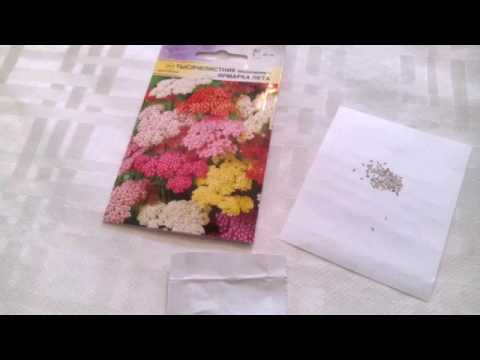

Watch this video on YouTube
Open ground planting rules
This culture grows best in sunny areas, but it is quite successfully grown in shaded areas. The soil on the site can be anything. Planting a yarrow in open soil is not a difficult task.
On the site you need to make holes, the depth of which should be about 10 centimeters. A plant should be placed in the middle of the hole along with a pot, while the remaining voids should be covered with soil. If the seedlings were grown in a common container, then it will be necessary to very carefully remove the seedling along with a clod of earth (try not to injure the root system), after which it is placed in a hole, which should be covered with earth. When all the plants are planted, the surface of the site must be tamped, and then abundant watering is done. Bushes grown from seeds begin to bloom in the last days of August.
Garden Yarrow Care
Yarrow will need regular watering only if the summer time is dry. In this case, the bushes should be watered no more than 1 time in 7 days. If the summer period is not very hot or it is rainy, then watering will be very rare.
During the season, plants will need 1 or 2 additional feeding, for this they use a complex mineral fertilizer for flowering plants. In some cases, tall varieties have to be tied up.
With the onset of autumn, the bushes need to be shortened to 10-15 centimeters. In areas with a warm climate, it is not necessary to cover the yarrow. But if a frosty and little-snow winter is expected, then the site must be covered with spruce branches or sprinkled with a layer of dry fallen leaves.
Once every 3 or 4 years, the bushes must be removed from the ground, divided into parts and planted in new places. This culture has one very important drawback, namely, the yarrow bushes can grow very strongly, while climbing into those areas that are not intended for it. To prevent this is quite simple, for this it is necessary to timely remove those inflorescences that have just begun to fade. In this case, you will be able to prevent self-seeding of the yarrow, as well as preserve the spectacular appearance of the bushes.
Harvesting yarrow
It is necessary to collect yarrow herb during its flowering period.The fact is that at this time the plant has the most powerful healing properties, and the largest amount of essential oil accumulates in the upper part of the bush. A cloudless and dry day is suitable for collecting grass, while the dew should completely evaporate from the foliage. To cut the grass, you can use a pruner, a sickle or a very sharp knife, when collecting a very large amount of raw materials, you can use a scythe. Only the upper part of the bush, about 0.2 m long, should be cut off. Rough shoots, on which there is no foliage, are not used as medicinal raw materials. If in the next season you want to collect the yarrow again, then you cannot pull out the bushes together with the roots.
The prepared raw materials for drying should be placed in a clean and dry room, and they can also be placed in the fresh air under a canopy. It should be noted that during drying, the direct rays of the sun should not fall on the grass, because they contribute to the destruction of essential oils and chlorophyll in the prepared raw materials. It should be distributed in a thin layer, while during drying, the grass must be systematically turned over, this will not allow it to start sweating. Also, if you wish, you can make bunches of grass, which are hung under the roof for drying. When it dries, you should cut off all the stems. You can understand that the yarrow is dry, because its shoots break off with ease, and the foliage and inflorescences crumble. Only leaf plates, flowers and shoots should be removed for storage, the length of which should not exceed 15 centimeters. All thick shoots must be cut and discarded. The finished raw material has a very strong aroma, while it has a slightly bitter taste. For storage, such a healing herb is poured into canvas bags, paper bags, cardboard boxes or glass jars, which are removed in a cool, dry and dark place. The herb retains its healing properties for 2 years. If the container is very well sealed, then the raw materials can be stored for up to 5 years.
Types and varieties of yarrow with a photo
There are a very large number of yarrow species, and most of them are cultivated by gardeners. Below will be given a description of those species and varieties that are most popular.
Yarrow (Achillea nobilis)
In nature, this species is found on the territory of the Ciscaucasia, Western Siberia, the south of the European part of Russia and Western Europe, while it prefers to grow in meadows, limestones, rocky slopes, in pine forests and steppes. The height of this perennial plant is about 0.65 m. Finely grooved shoots can be branched in the upper part or simple, they are densely leafy and colored greenish-gray. The lower stem and basal leaf plates are oblong-elliptical or ovoid, twice or thrice pinnately dissected and have petioles. Complex dense corymbose inflorescences consist of baskets. The color of the marginal flowers is light yellow or white. Cultivated since 1561.
Yarrow (Achillea macrocephala)
A slender bush is decorated with shields, reaching 6–14 centimeters across and painted white. The height of straight leafy shoots varies from 0.35 to 0.6 m. Lanceolate whole leaf plates are double-serrate.
Yarrow (Achillea filipendulina)
In nature, this kind can be found only in Central Asia and the Caucasus. The height of this perennial plant is about 1.2 m. Cirro-separate openwork leaf plates are painted green-gray. In diameter, the baskets reach 0.5 centimeters, they are part of flat corymbose inflorescences, the diameter of which is about 13 centimeters. Baskets consist of middle tubular flowers of yellow color and marginal reeds with a golden hue. The following varieties are cultivated:
- Coronation Gold... The height of the bush is about 0.8 m. The scutellum inflorescences are very dense and reach 15 centimeters in diameter.
- Eltgold... The inflorescences have a color similar to old gold with a hint of copper. They look beautiful against the background of green-gray leaf plates.
- Flowers of Self... Baskets are sulfur-yellow in color, and leaf plates are greenish-gray.
- Gold Plate... The height of the bush is about 1.2 m. Convex corymbose inflorescences have a dark yellow color.
- Parker... The height of such a tall variety is about 1.2 m. The color of the corymbose inflorescences is yellow-golden.
- Moonshine... The height of the bush varies from 0.4 to 0.6 m. Scalate inflorescences have a yellow-lemon color.
- Schwellenburg... The height of the bush varies from 0.2 to 0.4 m.
Yarrow ptarmica (Achillea ptarmica), or sneeze herb
In nature, this species is found in the European part of Russia and in Central Europe. This perennial plant has a creeping rhizome. The height of the compact bush is about 100 cm. Straight leafy shoots. Alternately sessile small solid leaf plates have a linear-lanceolate shape and a serrated edge. Loose corymbose inflorescences consist of baskets, painted in a pearl-white color and reaching 15 mm in diameter. It has been cultivated since 1542. Once this species was very popular. There are several varieties and garden forms. Terry varieties:
- Pearl oyster (Pearl)... The height of the bush is about 0.75 m. Terry baskets are white and reach 20 mm in diameter.
- Boulle de Neige... The height of the bush varies from 0.45 to 0.6 m.
- Perris White... The height of the bush is 0.8–1 m. It is decorated with double inflorescences.
- Pearl Blaupunkt and the Ballerina... The height of the bush is from 0.5 to 0.6 m, terry inflorescences bloom on them. It is noteworthy that in the Ballerina variety, the inflorescences relatively quickly acquire a dirty grayish color shade.
- Stephanie... This variety was born not so long ago. Its double inflorescences are colored lilac.
Felt Yarrow (Achillea tomentosa)
Under natural conditions, this species can be found on the territory of South-Eastern Europe and Western Siberia. It is cultivated by gardeners, as a rule, in rock gardens, as it promotes the formation of carpet thickets. The height of the bushes is only 0.15 m, but they grow strongly in width and can reach about 0.45 m in diameter. There is pubescence on the surface of the silvery pinnately dissected leaves. For the winter, the leaves do not die off, but are very tightly pressed against the surface of the site. Shield-shaped inflorescences, reaching 70 mm in diameter, consist of baskets of yellow-lemon color. The most popular variety is Aurea (Maynairds Gold): the height of the bushes is about 0.2 m, the baskets are painted in a rich yellow color.
Yarrow (Achillea millefolium), or medicinal yarrow
Under natural conditions, this species can be found in the Far East, in Western and Eastern Siberia, in the European part of Russia, in the Caucasus, in Western Europe and in Ukraine. Straight shoots reach 0.8 m in height. Alternate double or triple pinnately dissected leaf plates have many lanceolate segments. The upper leaves are sessile, and the lower ones have petioles. If you grind the leaves, you can feel a specific smell. Shield inflorescences consist of small baskets, reaching 0.7 cm in diameter. Baskets consist of yellow tubular flowers and reed flowers - pink, white or purple. It has been cultivated since 1440. It is cultivated both as a medicinal plant and as an ornamental plant. The most attractive varieties:
- Paprika... The marginal flowers are cherry red, they fade in the sun over time.
- Red Velvet... The baskets are painted in the color of ripe cherries. The color remains saturated until the flowers wither.
- Walter Funch... The shield-shaped inflorescences are the color of salmon eggs.
- Great Expression... The baskets are colored deep yellow.
- Mary Ann... The scutellous inflorescences are colored in a light lemon color.
- Terracotta... The color of the reed flowers is orange-brown.
- Lilac Beauty... The baskets are painted in a classic lilac color.
- Summervine... Shield inflorescences have a rich crimson color.
- Summer Pastels... The baskets are painted in an orange or pale pink color.
- Appleblossom... The bush grows very quickly, and it reaches a height of 0.4 m. The scutellum inflorescences are pinkish-white.
- White Beauty... The baskets are snow white.
- Serise Queen... The marginal flowers are cherry-colored.
Even gardeners sometimes cultivate such species as: ptarmicoloured yarrow, atrata, ageratol, golden-haired, or golden, umbrella, Keller, Serbian, erba-rotta, alpine, spaced, Sudeten, etc.


Watch this video on YouTube
Yarrow properties: harm and benefit
Useful properties of yarrow
The fact that yarrow has medicinal properties became known for a long time. Therefore, this plant has been used in alternative medicine for many centuries. Yarrow contains tannins, which have anti-inflammatory, strengthening, antibacterial and sedative effects. Such substances tone up the skin and eliminate irritation; therefore, it is recommended to use them for porous and acne-prone skin, with sweating, with oily seborrhea of the face, and also as a hair strengthening agent. Yarrow also contains vitamin K, which helps to increase the strength of the capillaries, stops hemorrhages and bleeding, and also heals wounds and ulcers. Due to the fact that this medicinal herb contains carotene, it helps to eliminate brittle hair and nails, as well as peeling, dryness and keratinization of the skin, prevents the appearance of acne and wrinkles.
This herb also contains essential oils, alkaloids, phytoncides, flavonoids, glycosides, bitterness, vitamin C, esters, choline, acetic, isovaleric and formic acids. Therefore, it helps to stimulate appetite and liver function, increase bile secretion, accelerate the absorption of substances, as well as improve digestion. It is used for diarrhea, dysentery, varicose veins, hemorrhoids, thrombosis and any bleeding as a hemostatic agent, and for gastritis and enteritis - as an anti-inflammatory. Preparations made on the basis of yarrow are used for colds and fever as a diaphoretic. Such a plant can help with various diseases, for example: it treats pulmonary tuberculosis, catarrh and stomach ulcers, kidney stones, malaria, female diseases, enuresis, anemia, headaches, hypertension.
Various medicinal preparations can be made from yarrow, for example: infusion, ointment, liquid extract, juice, decoction and oil. Some of these products can be made by hand, while the rest are sold in pharmacies.
Recipes
- Decoction... 1 tbsp. freshly boiled water must be combined with 1 small spoonful of chopped herbs of such a plant. Boil the mixture over low heat for 5 to 10 minutes. The cooled broth must be filtered. Drink the product should be ½ tbsp. three times a day for stomach ulcers and gastritis.
- Tincture... Pour 30 grams of dried yarrow herb into a vessel made of dark glass, and then pour 100 milligrams of medical alcohol into it. The tightly sealed vessel is removed in a cool and dark place. The infusion will be ready after 10 days. Alcohol can be replaced with vodka, but in this case, the product will be ready after 12 days. In case of bleeding and painful sensations, the agent is taken orally in 30-40 drops, which must first be combined with 50 milligrams of water.This product is suitable for treating wounds, as well as for making compresses.
- Ointment... Take a handful of fresh yarrow flowers and foliage. Grind them well in a mortar and combine with melted unsalted lard in a 1: 1 ratio. This remedy is used for bruises.
Contraindications
Means made on the basis of yarrow are forbidden to use in case of increased blood clotting and diseases associated with this condition. The juice of this plant should not be used during pregnancy. If you have absolutely no contraindications, then you should remember that if such drugs are used for a long time, this can cause the development of poisoning: a rash appears on the skin surface, and dizziness is also felt.

